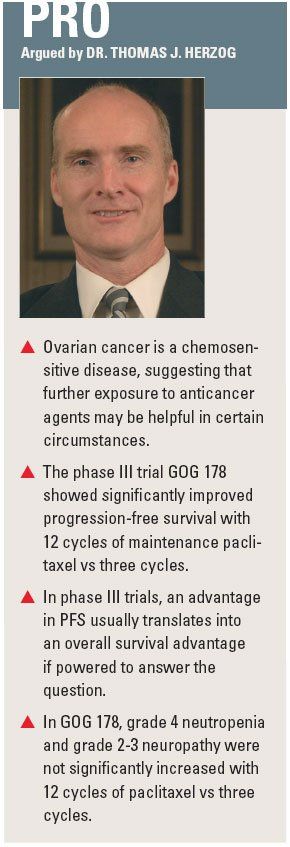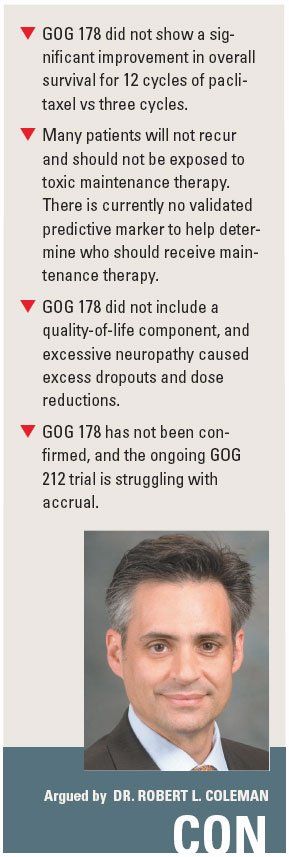Should advanced ovarian ca patients in CCR be offered maintenance therapy?
SAN FRANCISCO-In a debate session at the 2008 Oncology Congress, neither speaker advocated maintenance therapy as the standard of care in patients with advanced ovarian cancer who achieve a complete clinical remission. But the “pro” speaker, Thomas J. Herzog, MD, of Columbia University Medical Center in New York, argued that the evidence in favor of maintenance therapy is strong enough that it should be discussed with these patients as an option, while the “con” speaker, Robert L. Coleman, MD, of Houston’s M.D. Anderson Cancer Center, called the evidence “premature.”
ABSTRACT: A phase III trial showed signifi cantly improved progression-free but not overall survival with 12 vs three courses of maintenance paclitaxel. Researchers hope GOG 212 will provide definitive answers.
SAN FRANCISCO-In a debate session at the 2008 Oncology Congress, neither speaker advocated maintenance therapy as the standard of care in patients with advanced ovarian cancer who achieve a complete clinical remission. But the “pro” speaker, Thomas J. Herzog, MD, of Columbia University Medical Center in New York, argued that the evidence in favor of maintenance therapy is strong enough that it should be discussed with these patients as an option, while the “con” speaker, Robert L. Coleman, MD, of Houston’s M.D. Anderson Cancer Center, called the evidence “premature.”
New strategies are needed in these patients since up to 70% recur, Dr. Herzog pointed out. Dr. Coleman countered that many patients do not recur and would be exposed unnecessarily to the toxicity of maintenance therapy. To date, there are no validated predictive markers to determine which patients are most likely to recur.
GOG 178
The rationale for maintenance therapy in ovarian cancer stems from the disease’s high sensitivity to chemotherapy. “It seems reasonable that further exposure to anticancer agents aft er primary therapy would be beneficial,” Dr. Herzog said.
SWOG S9761/GOG 178 provides the foundation for offering patients maintenance therapy, Dr. Herzog said. Patients with stage III-IV disease who had a complete clinical response to primary therapy were randomized to receive three or 12 cycles of monthly paclitaxel at a dose of 175 mg/m2, which was reduced to 135 mg/m2 (JCO 21:2460-2465, 2003).
When the study showed a large difference in progression-free survival (PFS) favoring the group that received a year’s worth of paclitaxel (28 months vs 21 months, P = .0023), the Data Safety Monitoring Committee shut the trial down. Updated analysis showed PFS of 22 months vs 14 months (P = .01).
Overall survival (OS) trended in favor of the 12-month paclitaxel group but was not significant. The updated analysis showed overall survival of 53 months for the 12-month group vs 46 months for the three-month group (P = .27). He noted that in an exploratory analysis, 12 months of paclitaxel resulted in superior OS among patients who achieved a CA-125 nadir of 10 U/mL or less (HR 0.59, P = .03).
Dr. Herzog noted that the study endpoints for GOG 178 were progression-free or overall survival. “It is important to include that conjunction [or],” Dr. Herzog stressed, “because people try to say the study was stopped too early when, in fact, it was executed as planned.”
He added that for phase III trials, “it is very rare to see a significant PFS that doesn’t translate into improved OS if appropriately powered to look at that,” but since GOG 178 closed early, it was not powered to look at OS.
The study showed higher levels of grade 2-3 neuropathy for the 12-month paclitaxel group. “Much has been made of this, but it was not statistically significant,” he said, “and there was no grade 4 neuropathy in this trial.”
An ongoing phase III trial, GOG 212, uses the same entry criteria as GOG 178 and is designed to provide a definitive answer as to the benefits of maintenance paclitaxel therapy. Patients are being randomized to three arms: observation, paclitaxel for 12 months, or the investigational polyglutumate paclitaxel Xyotax (paclitaxel poliglumex) for 12 months. The study endpoints are PFS and OS.
“There has been lagging accrual,” Dr. Herzog said, “but with almost 500 patients on study, we are about one-third of the way there.”
In conclusion, Dr. Herzog said that patient counseling is critical: “I believe patients should be told of the value of maintenance therapy according to the GOG 178 data, and allowed to make their own decisions.”
‘Maintenance strategies have failed’


Strategies to prolong PFS in patients with advanced ovarian cancer who achieve a CCR after frontline therapy have not been successful, Dr. Coleman said. He reviewed a number of such approaches, including some “which may not be maintenance exactly,” he said.
Studies have shown no benefit from extending initial therapy, ie, from 5 to 10 cycles or from 6 to 12 cycles, and two studies designed to assess maintenance topotecan- MITO-1 and AGO/GINECO-also showed no difference in PFS. “Short duration of a non-cross-resistant drug in the maintenance setting did not add anything to PFS,” he said, and neither did 6 months of paclitaxel in the After-6 trial.
Dr. Herzog countered that extending initial therapy is not the same as maintenance therapy, and that the maintenance trials mentioned offered suboptimal duration of therapy.
Other failed attempts to prevent recurrence, Dr. Coleman said, include highdose chemotherapy with stem cell support, whole-abdominal radiotherapy, and intraperitoneal 32P given after negative second-look surgery; immunotherapy (interferon-alfa); and a monoclonal antibody oregovomab (Ovarex), which showed no activity initially or in a follow-up trial of patients with rapid normalization of CA 125 after primary therapy. Finally, a biologic agent, OV-12 (tanomastat), given until progression or for 5 years, “so it was clearly not stopped too early,” had no effect, Dr. Coleman said.
Dr. Herzog commented that the radiotherapy results “have nothing to do with the argument at hand.” And regarding the other failed “maintenance” therapies, he deadpanned, “Something that doesn’t work, won’t work.”
A curious result
Dr. Coleman then turned his attention to GOG 178 and what he called a curious result. Th e failure rate in the 12-cycle arm was relatively consistent at each time point, but patients in the three-cycle arm had a high failure rate aft er completing treatment, which then normalized. “This raises the question, could the two arms end up at the same point in terms of survival?” he asked.
A further question is whether secondline therapy given at recurrence is as eff ective as maintenance therapy. Dr. Coleman pointed to the retrospective University of Oklahoma study (Gynecol Oncol 95:157, 2004) that looked at 59 patients who met the criteria for GOG 178 but did not receive maintenance therapy.
The patients in this group who recurred (median, 20 months) received secondline therapy (40% received combination therapy), and aft er another relapse, they received third-line therapy (median, 43 months). The GOG 178 patients treated with 12 paclitaxel courses had PFS of 28 months between completion of maintenance therapy and recurrence; they received third-line therapy at a median of 40 months-“about the same” as seen with second-line chemotherapy given at recurrence, Dr. Coleman said.
He called this finding “hypothesis generating,” and said that although this cross trial comparison doesn’t negate GOG 178’s findings, “it raises questions as to whether extended PFS always translates into extended OS.”
Dr. Herzog responded that “it’s a very difficult argument to make, comparing level 1 phase III evidence to some historical data.”
Dr. Coleman further said that the toxicity issues of maintenance therapy “do need to be addressed.” Grade 3 neurotoxicity interferes with normal activities of daily living, and grade 2-3 peripheral neuropathy was the main reason for early termination in the GOG 178 12-cycle patients, he said.
For Dr. Coleman, the biggest criticism of GOG 178 is the lack of a confirmatory trial. He pointed out that GOG 212 is struggling with accrual.
He concluded: “The rationale for maintenance therapy is suspect, as a multitude of approaches have not shown an impact on outcomes in this setting. The pivotal GOG 178 trial was toxic, unconvincing, and unconfirmed to date.”
Late Hepatic Recurrence From Granulosa Cell Tumor: A Case Report
Granulosa cell tumors exhibit late recurrence and rare hepatic metastasis, emphasizing the need for lifelong surveillance in affected patients.